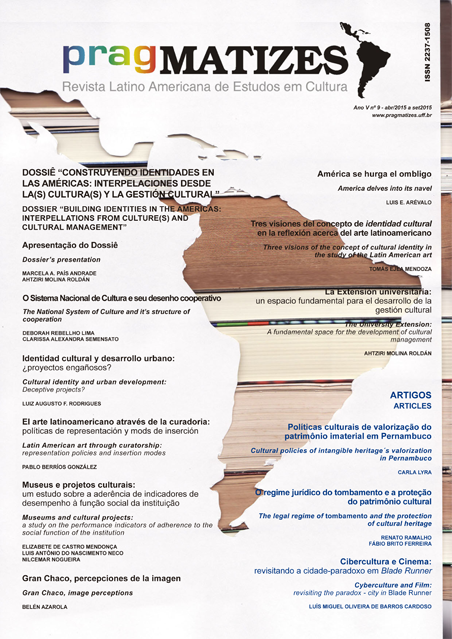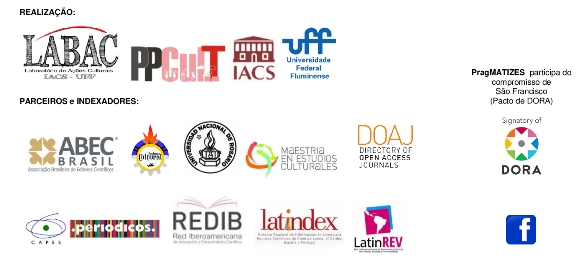Latin American art through curatorship: representation policies and insertion modes
DOI:
https://doi.org/10.22409/pragmatizes.v0i9.10410Abstract
This article approaches the conceptual construction of Latin American art that is realized from the structuring of contemporary curating, as a particular mode of artistic discourse. Thus, this presentation is divided into two parts: the first offers a brief genealogical exploration about curating and its links with the production conditions of globalized contemporary capitalism that allow its rise in a globalized artistic field. The second part analyzes the circulation of Latin American art through the curatorial representation, that generates a new way of understanding and insertion of Latin American artistic phenomenon on the global stage.Downloads
References
ALONSO, Luis; GARCÍA, Isabel. Diseño de exposiciones. Concepto, instalación y montaje. Madrid: Alianza, 1999.
BASTÚS, Joaquín. Suplemento al Diccionario histórico enciclopédico. Barcelona: Imprenta de Boca, 1833.
BAYÓN, Damian. América Latina en sus Artes. México: Siglo XXI, 2006.
BAYÓN, Damian. El artista latinoamericano y su identidad. Caracas: Monte Ávila, 1977.
BUCHLOH, Benjamin. Since realism there was… (on the current conditions on factographic art). En: Art & Ideology. New York: The New Museum of Contemporary Art, 1984. p. 5-11.
CALVO, Francisco. El Salón. En: BOZAL, Valeriano (ed.). Historia de las ideas estéticas y teorías del arte contemporáneo. Vol. 1. Madrid: Visor, 1996. p. 172–185.
CERVIÑO, Mariana. El circuito internacional del arte en los primeros noventas. Buenos Aires: UBA, 2011.
EDER, Rita. Arte e identidad en América Latina. En: Bienal de La Habana para leer. Valencia: Universitat de Valencia, 2009, p. 56.
GIUNTA, Andrea. América Latina en disputa. Apuntes para una historiografía del arte Latinoamericano. Disponible en <http://servidor.esteticas.unam.mx/edartedal/PDF/Oaxaca/complets/giunta_oaxaca96.pdf>. Acceso 12 jul. 2013.
GIUNTA, Andrea. Cuándo empieza el arte contemporáneo? / When Does Contemporary Art Begins?. Buenos Aires: Fundación ArteBA, 2014.
LEÓN, Dermis. La institucionalidad y el profesional en la figura del curador Chile. Disponible en <http://www.visualartchile.cl/espanol/invitados/7_leon.htm> . Acceso 26 jun. 2013.
MATTOS, Carlos de. Modernización capitalista y transformación metropolitana en América Latina: cinco tendencias constitutivas. En: GERAIGES DE LEMOS, Amalia; ARROYO, Mónica; SILVEIRA, María Laura. América Latina: Cidade, campo e turismo. São Paulo: CLACSO, 2006.
MOSQUERA, Gerardo (ed.). Beyond the fantastic. Contemporary art criticism from Latin America. Londres: Institute of International Visual Arts, 1995.
MOSQUERA, Gerardo. Caminar con el diablo. Textos sobre arte, internacionalismo y cultura. Madrid: Exit, 2010.
O’NEILL, Paul. The curatorial turn: from practice to discourse. En: RUGG, Judith; SEDWICK, Michèle (eds.). Issues in curating contemporary art and performance. Briston: Intellect Books, 2007. p. 13-28.
OBRIST, Hans Ülrich. A briefhistory of curating. Zürich: JRP-Ringier, 2000.
PELUFFO, Gabriel. Latinoamericanidad y experiencia artística contemporánea. En: POWER, Kevin (ed.) Pensamiento crítico en el nuevo arte latinoamericano. Lanzarote: Fundación César Manrique, 2006. p. 411–425.
RAMÍREZ, Mari Carmen. Brokering identities. Art curators and the politics of cultural representation. En: FERGUSON, Ross; GREENBERG, Reesa; NAIRNE, Sandy (eds.). Thinking about exhibitions. Londres: Routledge, 1996. p. 21-38.
SERVIDDIO, Fabiana. Crítica y Arte en Latinoamérica durante los años setenta. Buenos Aires: Dávila & Miño, 2012.
TRABA, Marta. Dos décadas vulnerables en las artes plásticas latinoamericanas. Buenos Aires: Siglo XXI, 2005.
TRABA, Marta. La pintura nueva en Latinoamerica. Bogotá: Ediciones Librería Central, 1961.
Downloads
Published
How to Cite
Issue
Section
License
By forwarding an original to PragMATIZES, the authors agree that the copyright related to it is transferred to the Publishing. Articles and other writings are made available in PDF format from their publication, and they can be downloaded to institutional repositories and personal pages, provided that with their proper bibliographic indication.



